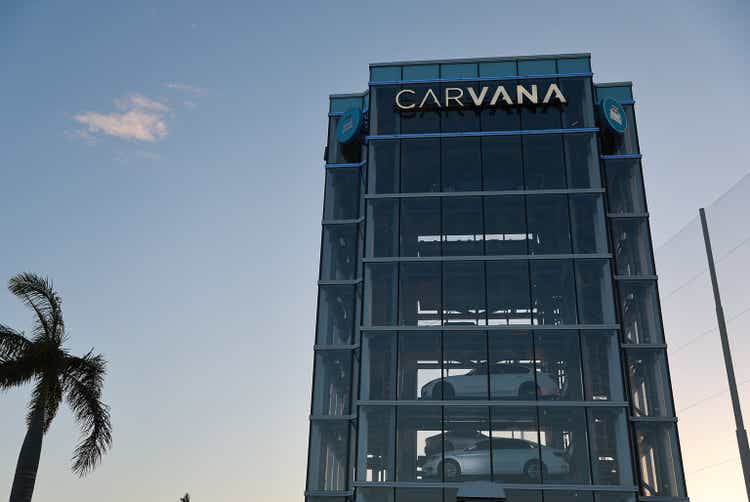[ad_1]
Joe Raedle/Getty Images News
In a new investor presentation filed late on Friday, Carvana (NYSE:CVNA) provided key updates to its strategy in an attempt to reassure a market skeptical of its path forward.
Shares of the Arizona-based online auto retailer have swung wildly in recent days, falling by nearly 20% on Wednesday before spiking over 40% higher at Thursday’s peak price. Still, despite strong single-day jumps in recent days, the stock has been hammered in 2022 to the tune of an over 80% drop.
Along with that decline, many investors and analysts have thrown in the towel on the company as its heavy debt only looms larger. In Friday’s update, the company attempted to respond to the crescendo of criticism.
In order to combat this negative attention, management outlined a plan led by 3 key priorities. Growing retail units and revenue, increasing total gross profit per unit, and demonstrating operating leverage were cited as pivotal steps.
“We have made significant progress on the first two objectives, while making progress, albeit more slowly, on the third as we have invested in rapid growth and GPU gains,” the report states. “In light of the current environment, we are elevating SG&A leverage, profitability, and positive free cash flow as priorities.”
What a Difference a Year Makes
In assessing recent headwinds, the report blamed seasonal shifts and a “variety of internal and external factors” for the recent poor performance in terms of this key priority.
The company admitted that in late 2018, there was underinvestment in operational infrastructure that hurt sales volume as demand picked up into 2019. In a likewise inopportune move, the company overcorrected by ramping investment in late 2019 only to be hit by COVID-19, which was blamed for elevated SG&A cost. In a sort of vicious cycle, management noted that another misplaced investment cycle impacted the company’s ability to address surging demand in 2021.
As sales have slowed to a trickle in 2022, the company’s string of operational mistakes has only been amplified. As a result, SG&A expenses spiked under the company’s explanation.
Moving forward, the company outlined its aim to reduce SG&A expense via rightsizing its compensation, advertising, logistics, and logistics spending. This includes headline reductions like reducing the company’s significant spending on advertising via various channels and headcount reductions.
“We estimate that our current footprint is built for more than double Q1 2022 retail units sold, providing significant opportunity for leverage as we grow into our existing footprint,” the document added.
Addressing ADESA
However, it is just that word, leverage, that remains a primary issue for Carvana (CVNA).
Chief among the drivers of the company’s debt burden is the acquisition of the ADESA auction business from KAR Global (KAR). The $2.2 billion acquisition has sparked serious financial maneuvering from management and required some last-minute assistance from Apollo Global Management (APO) as the retailer reportedly struggled to find takers for its bond offering.
Despite the downbeat implications from the deal, the company remained steadfast in its strategy predicated upon the costly purchase. The report cited faster delivery times and the larger footprint facilitated by the acquisition as net positives for the company’s pursuit of profitability.
“We have a tremendous level of conviction in both the long-term value of ADESA, its unique strategic assets, and its team, as well as our ability to generate positive free cash flow to service the financing associated with the purchase price and pre-funded capital expenditures,” the update states. “ADESA also generates meaningful benefits in the near-term by facilitating incremental unit economics and simplifying aspects of our last-mile delivery and logistics network.”
The company reiterated a long-term view, indicating its belief that the cost of its new financing plan to fund the acquisition is “much smaller than the headline [10.25%] interest rate suggests.”
“Taking a longer-term view, we believe acquiring ADESA will ultimately prove to be a pivotal moment on our path to becoming the nation’s largest and most profitable automotive retailer,” the report concludes, stressing commitment to the plan communicated prior to the acquisition.
Salary and Staff Cuts
The update reflected less commitment to maintaining staffing and salary levels.
The update confirmed the layoff of 2,500 employees, making up about 12% of its workforce. The report adds that lower payroll, “scheduling optimization”, and insourcing will also be leveraged to cut costs.
It is worth noting that no staff cuts are set to hit ADESA, as “business as usual” is a priority for the new subsidiary as it is integrated.
“The first priority for integrating ADESA and Carvana will be to ensure we continue to provide great value and customer service to ADESA’s existing buyers and sellers,” the operational update explains. “To this end, the ADESA physical auction business will continue to be run by the same leadership team who managed the business at KAR Global, helping to ensure a seamless transition.”
As far as payroll, the update explicitly states Carvana (CVNA) executives will “be forgoing their salary for the remainder of the year to contribute to the severance pay for departing team members.” The laid-off employees will also receive healthcare benefits for three months, job-seeking support, and retain the “unvested value of previous Carvana (CVNA) Shares equity awards.
The value of those equity awards, given the stock’s steep slide as of late, are considerably less attractive than they might have been when CEO Ernie Garcia III’s father was selling billions in 2021.
Read more on the stock’s recent swings and still heavily-shorted status.
[ad_2]
Source link





More Stories
Discover the Best Finance Agency for Your Investment Goals
How a Finance Agency Helps You Plan for the Future
The Key to Smart Investing with a Finance Agency